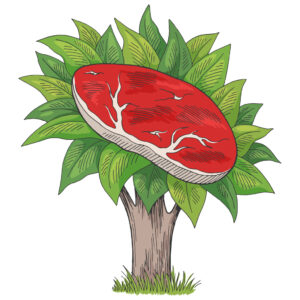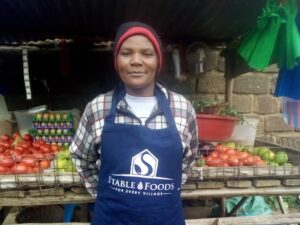A note from Jennie Moss, managing director, Rethink Events: In this fascinating interview, Banks Baker pinpoints many of the critical themes in animal health and nutrition that we’ve also been hearing from the Animal AgTech Advisory Board and network. New and next-gen technologies in animal feed, preventative health, and precision monitoring are critical to building a sustainable, high-welfare livestock industry, and the support of global brands like McDonald’s will have an enormous impact.
W. Banks Baker, manager of animal welfare at McDonald’s, didn’t always live in a big city like Chicago where he is now based. His background involves spending several years on farms in various capacities.
“I ended up working on the farm at my college for a number of years and fell in love with agriculture,” Baker tells AFN. “After that, I got an interesting internship managing a ranch at the Rocky Mountain Institute. Then, I ended up managing a pasture-based, stacked enterprise system with a small grass-fed dairy, some beef, a lot of pastured poultry, Berkshire pigs, and hair sheep. I started seeing some incredible improvements to the land as I managed it a little differently. I realized there wasn’t enough quantification about some of the changes and systems.”
Baker headed to Colorado State to earn his masters in agriculture to address this shortcoming before learning about the opportunity to work at McDonald’s. Although this farm boy-turned-city slicker admits he misses the farm, he’s been in his corporate role for nearly three years.
We caught up with Baker ahead of his speaking role at the Animal AgTech Innovation Summit in San Francisco on March 16 to learn more about how McDonald’s thinks about animal welfare in its supply chain.
What are the biggest sustainability challenges McDonald’s faces in animal welfare and supply chain sustainability?
I think everyone knows McDonald’s is the world’s largest global restaurant company. With that, we’ve made some ambitious commitments around sourcing goals and sustainability and welfare. What’s interesting here is that we are doing all of that but we don’t own any farms or ranches; we don’t raise animals to source products that meet our specifications. It means we have to work with and across the industry to make those changes.
When we do that, it also means that when we commit to something, our impacts are very significant because of our footprint and when we make progress we have to do it at a large enough scale to satisfy our volumes. Cage-free eggs have made progress. We have seen other companies make similar commitments and see that reverberating through the retail sector.
We like to think we have the best suppliers in the entire world and we have one of the best supply chains in the entire world. We have very good relationships with suppliers.
McDonald’s announced its plans to use only cage-free eggs by 2025 in 2015. As of April 2019, the company reported that one-third of its egg supply, totaling 726 million cage-free eggs, will be sourced from cage-free animals.
What initiatives has McDonald’s put in place to try to overcome the challenges you face in animal welfare?
I sit on McDonald’s US Sustainability Team and work on some of our global projects focusing on proteins, sustainability, animal health and welfare, antibiotic policies, GHG reduction strategies. Beef sustainability is one in that we are doing a lot of work around accelerating industry progress through the US Roundtable for Sustainable Beef and supporting programs around sharing knowledge of tools. Grazing management trainings and supporting soil health trainings for the farmer, which end up laddering up to McDonald’s GHG reduction commitments. In our Flagship Farmer Program, we identified our top 10 beef markets and our flagship farmers are folks who are exemplary in the production systems they are in and provide an example to colleagues and counterparts. There is also the SMART Broiler Research Initiative (more detail on that one below).
We are doing things around pioneering new practices. We provided over $4 million worth of funding for an adaptive multi-paddock grazing study at Arizona State University asking whether we can use this method at the cow-calf level and if so how much carbon can be sequestered. We will continue to support grazing management trainings that allow that information to be disseminated more broadly.
You can review McDonald’s many different animal welfare commitments on its website.
Where and how does technology play a role in overcoming these challenges?
Technology does play a role and it will continue to play a bigger and bigger role. These commitments are making us look further and further back in the supply chain, in many cases, to the production level. Ways that we can track, monitor, and validate some of the progress for those commitments in a commodity level supply chain need to be advanced. At the Animal AgTech Innovation Summit, I have an interesting project I will be highlighting. McDonald’s was the first global restaurant company to come out with an outcomes-based animal health and welfare strategy for broilers (meat chickens). This is opposed to just following a specific set of parameters or protocols about how our suppliers should raise broilers. We are going to measure the actual outcomes of welfare itself.
We devised a system using what we call key welfare indicators similar to a key performance indicator for business. We will collect information across a large portion of our supply chain and aggregate in a database and allow that data to inform where opportunities exist and where we should be setting improvement thresholds. A good example of a key welfare indicator is footpad lesions. When a bird is in a littered environment if it is managed poorly it becomes wet and acidic so you will see lesions on the birds’ footpads.
We also committed $2 million over two years to identify technology that can help us monitor welfare at the farm level. We partnered with the Foundation for Food and Agriculture Research, which matched our $2 million. We released a global open request for proposals and used that $4 million as a bounty for tech that can help us automatically monitor and report key welfare indicators in a standardized and representative way. We are finalizing those participants and hope to announce them at the summit.
What types of technology have caught your eye so far?
It has to be at the farm level and commercially viable. Precision monitoring on the video side, for example. One researcher we are excited about releasing is taking open-sourced flock level aggregate movement software that is used for in-security purposes to identify terrorist activity in a large crowd. It tracks the mean of movement and picks out any anomalies. We are trying to apply that to the animal space and asking whether we can use that to monitor flocks.
Another one is a precision audio tech and what they are doing is using some fairly off the shelf microphones. Researchers are working with identified specific tones and vocalizations from broilers and using those as indicators about their environment.
The majority of broilers are raised by contract growers who work with an integrator that owns the birds, the feed, the pharmaceuticals, and other inputs. Who ultimately pays for the technology that you will recommend in your supply chain?
We work closely with suppliers and they have their own relationships with growers who raise those animals. When we are done with our Smart Broiler program, we won’t say that these are the techs we have identified that you have to use, we will say “measure these things and we will need them provided in this standardized format. We have invested with you in tech that can allow you to do this. This is our recommendation. We like this data in this format uploaded at this frequency.” As long as they are doing that, they can do it any way that makes sense for them.
Regarding who pays, we are starting off with these single technologies. There will be some apprehension as far as adoption but as they get adopted, and other potential system efficiencies are generated through making data actionable, while shooting to improve welfare. But as we do that, we are increasing other efficiencies like product quality or quantity and food safety that provide benefits beyond welfare.
What do you think the future is for meat vs. plant-based vs. other alternatives like cultivated meat? Why has McDonald’s been slow to uptake alternative protein compared to other QSRs?
I don’t know if I can speak to that but what I can say is McDonald’s is going to continue listening to the customer and providing products they crave and desire. We are in the business of giving customers what they want. For us, it’s about providing customers with choice. We have markets around the world that are offering a variety of products including some plant-based or meat alternative type products. Really for us, it’s about delivering what customers want. In Canada, we are piloting a plant-based option and looking at consumer preference and how that impacts the operations of our business at the restaurant level and sourcing level.
Banks Baker is among the 50 expert speakers at Animal AgTech Innovation Summit in San Francisco on March 16. His Fireside Chat – Transforming the Industry from Farm to Fork through Collaboration – with Karen Christensen of Tyson Foods and Tim Kurt of FFAR will be one of the program highlights. 350+ international livestock producers, animal health providers, feed companies and ingredients manufacturers will join technology providers, entrepreneurs and investors to share innovation and experiences. See the program and register to join them at www.animalagtech.com.
*This article was sponsored by Rethink Events, an AgFunder Network Partner. Find out more here.*

















Sponsored
International Fresh Produce Association launches year 3 of its produce accelerator